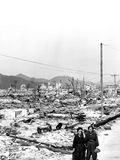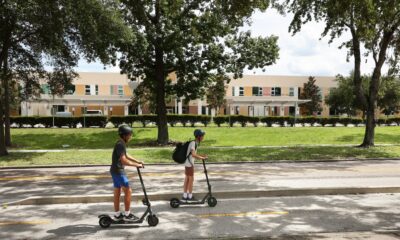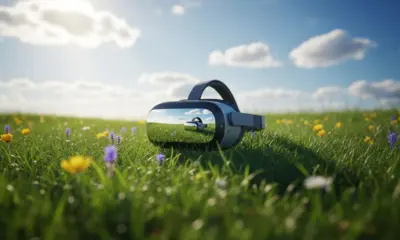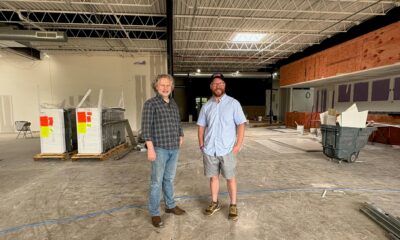Science
Hiroshima’s Survivors Share Their Stories Eight Decades Later

Survivors of the atomic bombings of Hiroshima and Nagasaki continue to recount their harrowing experiences as the world marks the 80th anniversary of these tragic events. Kazumi Kuwahara, a third-generation hibakusha, shared her story during a recent conference in London, emphasizing the long-lasting effects of the bomb on her health and the emotional burden carried by survivors.
At just 29 years old, Kuwahara articulated her ongoing struggles with illness, stating, “I have always had a weak body,” a sentiment that echoes throughout her family history. Her grandmother, Emiko Yamanaka, who directly experienced the bombing, has often expressed remorse, saying, “I’m sorry, it’s my fault.” This family dynamic illustrates the continuing impact of the atomic bomb on both personal and collective levels.
The Day the World Changed
The atomic bomb, codenamed “Little Boy,” was dropped on Hiroshima at 8:15 AM on August 6, 1945, resulting in catastrophic destruction. The bomb exploded approximately 600 meters above Shima Hospital, creating a fireball with temperatures reaching 3,000–4,000 degrees Celsius and a mushroom cloud ascending 16 kilometers into the sky. The immediate aftermath saw widespread devastation and loss of life, with estimates suggesting that roughly 50 percent of the inhabitants within 4 kilometers of ground zero perished.
In the years that followed, survivors faced significant challenges, including societal stigma and discrimination. The Japanese military initially imposed censorship on discussions of the atomic bomb, a restriction that persisted during the subsequent U.S. occupation, which began on September 2, 1945. As a result, many hibakusha struggled to share their experiences, often suffering in silence.
Personal Stories of Survival and Resilience
Yamanaka was only 11 years old when she experienced the bombing. She vividly recounted her journey into Hiroshima that morning, attempting to reach an eye doctor while dodging air-raid warnings. “When I got to Sumiyoshi shrine, the strap of one of my wooden geta snapped off,” she remembered. As she attempted to fix it, a blinding flash enveloped her, followed by chaos and destruction. “I cried out: ‘I can’t breathe! I’m choking! Help me!’” This moment marked the beginning of a lifetime of trauma.
After the bombing, Yamanaka managed to escape the immediate danger but faced further struggles as she searched for her family. She found her home destroyed, and her mother severely injured. “All those sounds horrified me,” she recalled, reflecting on the desperation and fear that gripped the city that night.
Studies have confirmed that the effects of the atomic bomb extended well beyond immediate physical injuries. Survivors, including Yamanaka, report long-term health issues, including various forms of cancer, blood disorders, and chronic fatigue, which have been linked to radiation exposure. As of March 31, 2025, the Japanese government recognizes approximately 99,130 survivors, many of whom are now in their eighties.
Despite the challenges, Kuwahara and others like her are determined to share their stories. Having participated in various speaking engagements, she aims to educate younger generations about the impacts of nuclear warfare. “Each visitor has a unique nationality and upbringing,” she noted, emphasizing her commitment to conveying the significance of Hiroshima’s history.
The stories of hibakusha are vital for understanding the historical context of nuclear warfare and its enduring effects on individuals and society. As John Hersey, author of the seminal work “Hiroshima,” stated, “What has kept the world safe from the bomb since 1945 has been the memory of what happened at Hiroshima.”
As the world reflects on the events of 1945, it is crucial to listen to the voices of those who survived. Their experiences serve as a reminder of the human cost of war and the importance of striving for peace. In a world where memories fade, the stories of survivors like Kuwahara and Yamanaka will continue to resonate, ensuring that the lessons of the past are not forgotten.
-

 Lifestyle3 weeks ago
Lifestyle3 weeks agoBelton Family Reunites After Daughter Survives Hill Country Floods
-

 Technology2 weeks ago
Technology2 weeks agoDiscover the Top 10 Calorie Counting Apps of 2025
-

 Education3 weeks ago
Education3 weeks agoWinter Park School’s Grade Drops to C, Parents Express Concerns
-

 Technology1 week ago
Technology1 week agoHarmonic Launches AI Chatbot App to Transform Mathematical Reasoning
-

 Technology3 weeks ago
Technology3 weeks agoMeta Initiates $60B AI Data Center Expansion, Starting in Ohio
-

 Technology3 weeks ago
Technology3 weeks agoByteDance Ventures into Mixed Reality with New Headset Development
-

 Lifestyle3 weeks ago
Lifestyle3 weeks agoNew Restaurants Transform Minneapolis Dining Scene with Music and Flavor
-

 Technology2 weeks ago
Technology2 weeks agoMathieu van der Poel Withdraws from Tour de France Due to Pneumonia
-

 Technology3 weeks ago
Technology3 weeks agoRecovering a Suspended TikTok Account: A Step-by-Step Guide
-

 Technology3 weeks ago
Technology3 weeks agoGlobal Market for Air Quality Technologies to Hit $419 Billion by 2033
-

 Health3 weeks ago
Health3 weeks agoSudden Vision Loss: Warning Signs of Stroke and Dietary Solutions
-

 Technology3 weeks ago
Technology3 weeks agoTrump Faces Internal Struggles Over Epstein Files Handling













